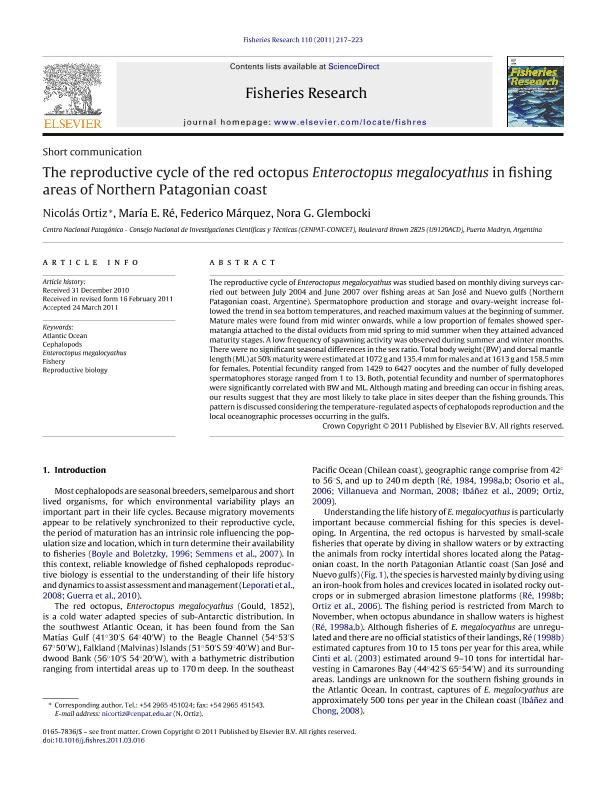Mostrar el registro sencillo del ítem
dc.contributor.author
Ortiz, Nicolás

dc.contributor.author
Re, Maria Edith

dc.contributor.author
Marquez, Federico

dc.contributor.author
Glembocki, Nora Gabriela

dc.date.available
2019-10-11T15:52:33Z
dc.date.issued
2011-06
dc.identifier.citation
Ortiz, Nicolás; Re, Maria Edith; Marquez, Federico; Glembocki, Nora Gabriela; The reproductive cycle of the red octopus Enteroctopus megalocyathus in fishing areas of Northern Patagonian coast; Elsevier Science; Fisheries Research; 110; 1; 6-2011; 217-223
dc.identifier.issn
0165-7836
dc.identifier.uri
http://hdl.handle.net/11336/85720
dc.description.abstract
The reproductive cycle of Enteroctopus megalocyathus was studied based on monthly diving surveys carried out between July 2004 and June 2007 over fishing areas at San José and Nuevo gulfs (Northern Patagonian coast, Argentine). Spermatophore production and storage and ovary-weight increase followed the trend in sea bottom temperatures, and reached maximum values at the beginning of summer. Mature males were found from mid winter onwards, while a low proportion of females showed spermatangia attached to the distal oviducts from mid spring to mid summer when they attained advanced maturity stages. A low frequency of spawning activity was observed during summer and winter months. There were no significant seasonal differences in the sex ratio. Total body weight (BW) and dorsal mantle length (ML) at 50% maturity were estimated at 1072. g and 135.4. mm for males and at 1613. g and 158.5. mm for females. Potential fecundity ranged from 1429 to 6427 oocytes and the number of fully developed spermatophores storage ranged from 1 to 13. Both, potential fecundity and number of spermatophores were significantly correlated with BW and ML. Although mating and breeding can occur in fishing areas, our results suggest that they are most likely to take place in sites deeper than the fishing grounds. This pattern is discussed considering the temperature-regulated aspects of cephalopods reproduction and the local oceanographic processes occurring in the gulfs.
dc.format
application/pdf
dc.language.iso
eng
dc.publisher
Elsevier Science

dc.rights
info:eu-repo/semantics/openAccess
dc.rights.uri
https://creativecommons.org/licenses/by-nc-nd/2.5/ar/
dc.subject
ATLANTIC OCEAN
dc.subject
CEPHALOPODS
dc.subject
ENTEROCTOPUS MEGALOCYATHUS
dc.subject
FISHERY
dc.subject
REPRODUCTIVE BIOLOGY
dc.subject.classification
Biología Marina, Limnología

dc.subject.classification
Ciencias Biológicas

dc.subject.classification
CIENCIAS NATURALES Y EXACTAS

dc.title
The reproductive cycle of the red octopus Enteroctopus megalocyathus in fishing areas of Northern Patagonian coast
dc.type
info:eu-repo/semantics/article
dc.type
info:ar-repo/semantics/artículo
dc.type
info:eu-repo/semantics/publishedVersion
dc.date.updated
2019-09-20T15:09:47Z
dc.journal.volume
110
dc.journal.number
1
dc.journal.pagination
217-223
dc.journal.pais
Países Bajos

dc.journal.ciudad
Amsterdam
dc.description.fil
Fil: Ortiz, Nicolás. Consejo Nacional de Investigaciones Científicas y Técnicas. Centro Nacional Patagónico; Argentina
dc.description.fil
Fil: Re, Maria Edith. Consejo Nacional de Investigaciones Científicas y Técnicas. Centro Nacional Patagónico; Argentina
dc.description.fil
Fil: Marquez, Federico. Consejo Nacional de Investigaciones Científicas y Técnicas. Centro Nacional Patagónico; Argentina
dc.description.fil
Fil: Glembocki, Nora Gabriela. Consejo Nacional de Investigaciones Científicas y Técnicas. Centro Nacional Patagónico; Argentina
dc.journal.title
Fisheries Research

dc.relation.alternativeid
info:eu-repo/semantics/altIdentifier/doi/http://dx.doi.org/10.1016/j.fishres.2011.03.016
dc.relation.alternativeid
info:eu-repo/semantics/altIdentifier/url/https://www.sciencedirect.com/science/article/pii/S0165783611001251
Archivos asociados
